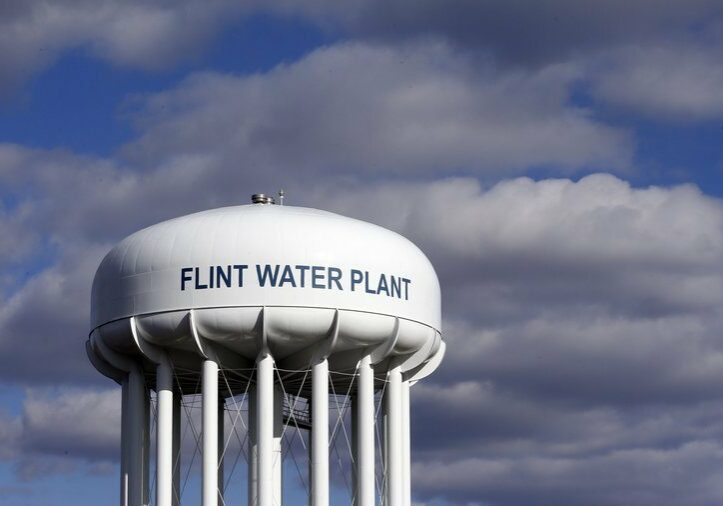Published in the May 2016 NJEA Review
by Adrienne Markowitz and Eileen Senn
Media coverage in the past year of the debacle in Flint, Michigan dramatically raised national awareness about lead poisoning from drinking water. Then in March, poisoning from the toxic metal hit home in New Jersey with the revelation of lead above the “Action Level” of 15 parts per billion in the drinking water in 30 of 67 public schools in Newark. Camden and Jersey City have long been distributing bottled water to students over concerns about lead levels. Camden has been doing so for 10 years at a cost of $75,000 per year.
Newark Public Schools (NPS) released historical data and scrambled to reconstruct what the district had done, in response to elevated levels, since testing began in 2004. Both the U.S. Environmental Protection Agency (EPA) and the New Jersey Department of Environmental Protection (DEP) had to step in to help NPS analyze its data and plan more sampling. It has become apparent that lead in drinking water is an issue too easily misunderstood and neglected. Advocates must ensure that every school district in New Jersey addresses the issue in an ongoing and scientifically correct way by following EPA guidance.
Any lead in drinking water is a concern
No amount of lead exposure, at any age or any level, is considered safe. The DEP and EPA 15 ppb Action Level is not a safe level, nor is a lower Action Level of 10 ppb recommended by the World Health Organization.
Lead poisoning remains the number one environmental health problem affecting children, despite bans on lead in paint, gasoline and solder in food cans. This is because large amounts of lead remain in paint and plumbing in buildings and in soil and dust. Lead in drinking water, although rarely the sole cause of lead poisoning, can significantly increase a person’s total lead exposure and is a health risk to people of all ages, from infants to adults. Lead in water is impossible to detect by sight, smell, or taste, so it must be measured.
EPA mandates corrosion control to reduce lead in water
 Lead enters drinking water through corrosion of plumbing materials, especially where the water is soft, has high acidity, low mineral content, or high chloride levels from road salt runoff. Corrosion is a dissolving away of metal caused by a chemical reaction between water and plumbing. Buildings built before 1986 are more likely to have lead or brass pipes, faucets, fittings, valves, and solder.
Lead enters drinking water through corrosion of plumbing materials, especially where the water is soft, has high acidity, low mineral content, or high chloride levels from road salt runoff. Corrosion is a dissolving away of metal caused by a chemical reaction between water and plumbing. Buildings built before 1986 are more likely to have lead or brass pipes, faucets, fittings, valves, and solder.
However, new schools are also at risk: even legally “lead-free” plumbing may contain up to 8 percent lead. Beginning January 2014, changes to the Safe Drinking Water Act further reduced the maximum allowable lead content of pipes, pipe fittings, plumbing fittings, and fixtures to 0.25 percent.
To address the leaching of lead and copper into drinking water, the EPA issued the Lead and Copper Rule under the authority of the Safe Drinking Water Act. The rule requires water providers to use corrosion control treatment and monitor drinking water at both the source and limited point-of-use outlets. If lead concentrations exceed an Action Level of 15 ppb in more than 10 percent of customer taps sampled, it does not signal a violation but can trigger other requirements on water providers, including water quality monitoring, corrosion control treatment, source water monitoring and treatment, public education, and lead service line replacement.
EPA recommends testing all water outlets used for drinking or cooking
For many years, the EPA has encouraged schools to voluntarily test for lead in water at all outlets used for drinking or cooking, include water coolers, bubblers and faucets. In its 3Ts (training, testing, and telling) technical guidance document, listed under “For more information,” the EPA provides detailed instructions on how to test correctly using a two-step process.
- Before school opens and any flushing or use occurs, draw 250 ml samples of stagnant water that has sat for at least eight hours.
- If initial test results reveal lead concentrations greater than 15 ppb for a given outlet, follow-up flush testing is recommended to determine if the lead contamination is from the outlet or from interior plumbing.
This EPA-recommended protocol maximizes the likelihood that the highest concentrations of lead are found.
EPA-recommended sampling should not be confused with EPA-required sampling by water utilities and other providers. The fact that required sampling has been conducted does not eliminate the need for the recommended sampling. For 90 percent of schools, results from required sampling are found in annual Consumer Confidence Reports found on the DEP Drinking Water Watch webpage. For the 10 percent of schools and childcare facilities that have wells and run their own water systems, results from required sampling are also found on the DEP webpage, under Non-Transient Non-Community (NTNC) public water systems.
Local association action plan
NJEA local associations have a critical role to play in ensuring school districts test properly and get the lead out of drinking water. The NJEA organizing approach is described in Ten Steps to School Health and Safety listed under “For more information” on the next page. It is a valuable guide to effective action—documenting problems, educating and assisting members, mobilizing with parents and community coalitions, and negotiating with the school district.
Local associations should work with their UniServ field representatives to determine if school officials have implemented the EPA’s 3Ts for reducing lead in drinking water. Locals should ask districts to provide documentation that the following 3T steps have been taken. If not, locals should insist that their districts begin to do so immediately.
Develop a plumbing profile: A plumbing profile helps schools identify potential problem areas and assess factors that contribute to lead problems. Lead contamination may not occur uniformly throughout a building and the 3Ts describe various factors that affect the likelihood of lead contamination in order to identify those areas as priorities for testing.
Develop a drinking water testing plan: The results of a plumbing profile will help schools create their testing plans. Key issues to consider include who will be in charge of the effort, who will collect and analyze the samples and maintain records, and where samples will be taken.
Test the school’s drinking water for lead: The EPA recommends the two-step sampling process to test for lead in drinking water described earlier in this article.
Correct problems when elevated lead levels are found: Addressing elevated lead levels in school drinking water typically requires both temporary and permanent solutions. The EPA recommends:
- Routine measures including aerator screen cleaning, using only cold tap water for food and beverage preparation, and staff and students running the water to flush the lead for a few minutes before use.
- Short-term solutions such as custodians flushing the entire piping system every morning or shutting down problem outlets and providing bottled water.
- Permanent solutions including replacing pipes, fixtures, faucets, or water fountains containing lead with lead-free alternatives; installing activated carbon filters or reverse osmosis units on faucets known as point-of-use devices; relocating grounding wires; reconfiguring plumbing to bypass lead sources; permanently shutting off problem outlets; and installing corrosion control devices for individual buildings, known as point-of-entry devices.
Communicate with the school community about a school lead control program: Schools should clearly and regularly communicate about their lead monitoring and reduction program to students, teachers, staff, parents and other members of the school community.
Adrienne Markowitz holds a Master of Science in Industrial Hygiene from Hunter College, City University of New York. Eileen Senn holds a Master of Science in Occupational Health from Temple University in Philadelphia. They are consultants with the New Jersey Work Environment Council, which is a frequent partner with NJEA on school health and safety concerns.
Lead health effects, testing and treatment
Lead is most damaging during pregnancy and the first few years of life, when it can disrupt brain development and result in lifelong learning and behavior problems. Young children and school staff and older students who are pregnant or nursing are most vulnerable and their blood lead level (BLL) should be tested.
In children, long-term exposure to lead at very low levels is associated with decreased hearing, lower intelligence, hyperactivity, attention deficits and problems in school. In adults, lead exposure at low doses can lead to adverse cardiovascular and kidney effects, cognitive dysfunction, and adverse reproductive outcomes.
Decreased renal function is associated with BLLs at 5 micrograms per deciliter (µg/dL) and lower. and increased risk of high blood pressure and essential tremor at BLLs below 10 µg/dL. In both children and adults, medium levels can cause stomach cramps, vomiting, weight loss, fatigue, and anemia. High levels can cause seizures, severe brain damage resulting in mental retardation, coma and even death.
Although the New Jersey Department of Health (NJDOH) uses a BLL of 10 µg/dL as the level of concern, anything above zero is above normal, indicating lead exposure from one or more sources has occurred. The federal Centers for Disease Control (CDC) uses 5 µg/dL as the level of concern. A level above 45 µg/dL is an emergency requiring hospitalization and consideration of chelation therapy to remove lead from the body.
If a person is poisoned by lead, the local health department will help the family and health care provider with treatment, if needed, and help in finding and removing the source(s) of lead—most commonly lead in paint, dust, soil, and water in the home, school, community, or workplace.
For more information
Note: All links are case sensitive.
Ten Steps to School Health and Safety, NJEA, April 2011, 12 pages
[Download not found]
U.S. Environmental Protection Agency (EPA)
N.J. Department of Environmental Protection (DEP)
- Lead in Water FAQs, bit.ly/leadwaterfaq
- Drinking Water Watch webpage, bit.ly/watersupplywatch
N.J. Department of Health
- Lead in Drinking Water Fact Sheet, bit.ly/leadwaterfactsheet
Adrienne Markowitz holds a Master of Science in Industrial Hygiene from Hunter College, City University of New York. Eileen Senn holds a Master of Science in Occupational Health from Temple University in Philadelphia. They are consultants with the New Jersey Work Environment Council, which is a frequent partner with NJEA on school health and safety concerns.
